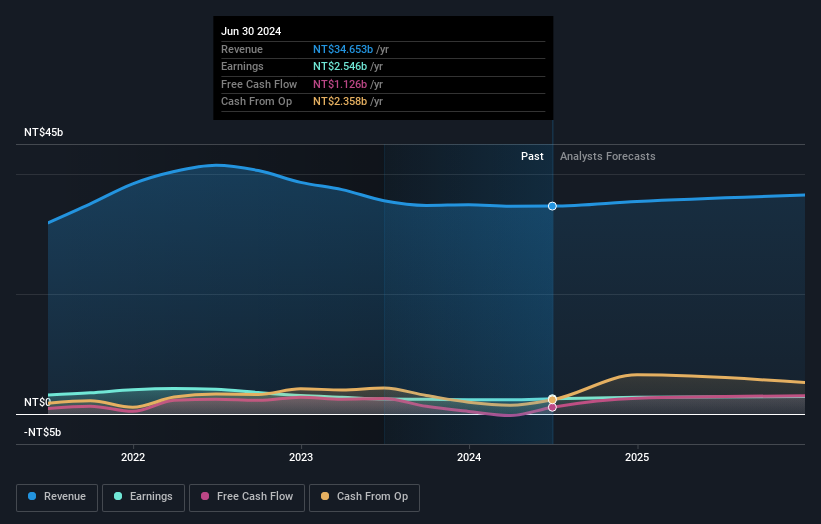- Taiwan
- /
- Metals and Mining
- /
- TWSE:2015
The five-year decline in earnings for Feng Hsin Steel TWSE:2015) isn't encouraging, but shareholders are still up 107% over that period

The main point of investing for the long term is to make money. Furthermore, you'd generally like to see the share price rise faster than the market. Unfortunately for shareholders, while the Feng Hsin Steel Co., Ltd. (TWSE:2015) share price is up 59% in the last five years, that's less than the market return. However, more recent buyers should be happy with the increase of 34% over the last year.
Although Feng Hsin Steel has shed NT$1.6b from its market cap this week, let's take a look at its longer term fundamental trends and see if they've driven returns.
View our latest analysis for Feng Hsin Steel
To quote Buffett, 'Ships will sail around the world but the Flat Earth Society will flourish. There will continue to be wide discrepancies between price and value in the marketplace...' One imperfect but simple way to consider how the market perception of a company has shifted is to compare the change in the earnings per share (EPS) with the share price movement.
During five years of share price growth, Feng Hsin Steel actually saw its EPS drop 1.1% per year.
So it's hard to argue that the earnings per share are the best metric to judge the company, as it may not be optimized for profits at this point. Therefore, it's worth taking a look at other metrics to try to understand the share price movements.
We note that the dividend has not increased, so that doesn't seem to explain the increase, either. It could be that the revenue growth of 6.6% per year is viewed as evidence that Feng Hsin Steel is growing. In that case, the company may be sacrificing current earnings per share to drive growth.
You can see below how earnings and revenue have changed over time (discover the exact values by clicking on the image).

Balance sheet strength is crucial. It might be well worthwhile taking a look at our free report on how its financial position has changed over time.
What About Dividends?
As well as measuring the share price return, investors should also consider the total shareholder return (TSR). Whereas the share price return only reflects the change in the share price, the TSR includes the value of dividends (assuming they were reinvested) and the benefit of any discounted capital raising or spin-off. It's fair to say that the TSR gives a more complete picture for stocks that pay a dividend. We note that for Feng Hsin Steel the TSR over the last 5 years was 107%, which is better than the share price return mentioned above. And there's no prize for guessing that the dividend payments largely explain the divergence!
A Different Perspective
Feng Hsin Steel shareholders are up 40% for the year (even including dividends). But that return falls short of the market. The silver lining is that the gain was actually better than the average annual return of 16% per year over five year. It is possible that returns will improve along with the business fundamentals. It's always interesting to track share price performance over the longer term. But to understand Feng Hsin Steel better, we need to consider many other factors. For instance, we've identified 1 warning sign for Feng Hsin Steel that you should be aware of.
Of course Feng Hsin Steel may not be the best stock to buy. So you may wish to see this free collection of growth stocks.
Please note, the market returns quoted in this article reflect the market weighted average returns of stocks that currently trade on Taiwanese exchanges.
New: AI Stock Screener & Alerts
Our new AI Stock Screener scans the market every day to uncover opportunities.
• Dividend Powerhouses (3%+ Yield)
• Undervalued Small Caps with Insider Buying
• High growth Tech and AI Companies
Or build your own from over 50 metrics.
Have feedback on this article? Concerned about the content? Get in touch with us directly. Alternatively, email editorial-team (at) simplywallst.com.
This article by Simply Wall St is general in nature. We provide commentary based on historical data and analyst forecasts only using an unbiased methodology and our articles are not intended to be financial advice. It does not constitute a recommendation to buy or sell any stock, and does not take account of your objectives, or your financial situation. We aim to bring you long-term focused analysis driven by fundamental data. Note that our analysis may not factor in the latest price-sensitive company announcements or qualitative material. Simply Wall St has no position in any stocks mentioned.
About TWSE:2015
Feng Hsin Steel
Manufactures, processes, and trades steel products in Taiwan.
Flawless balance sheet established dividend payer.
Similar Companies
Market Insights
Community Narratives




